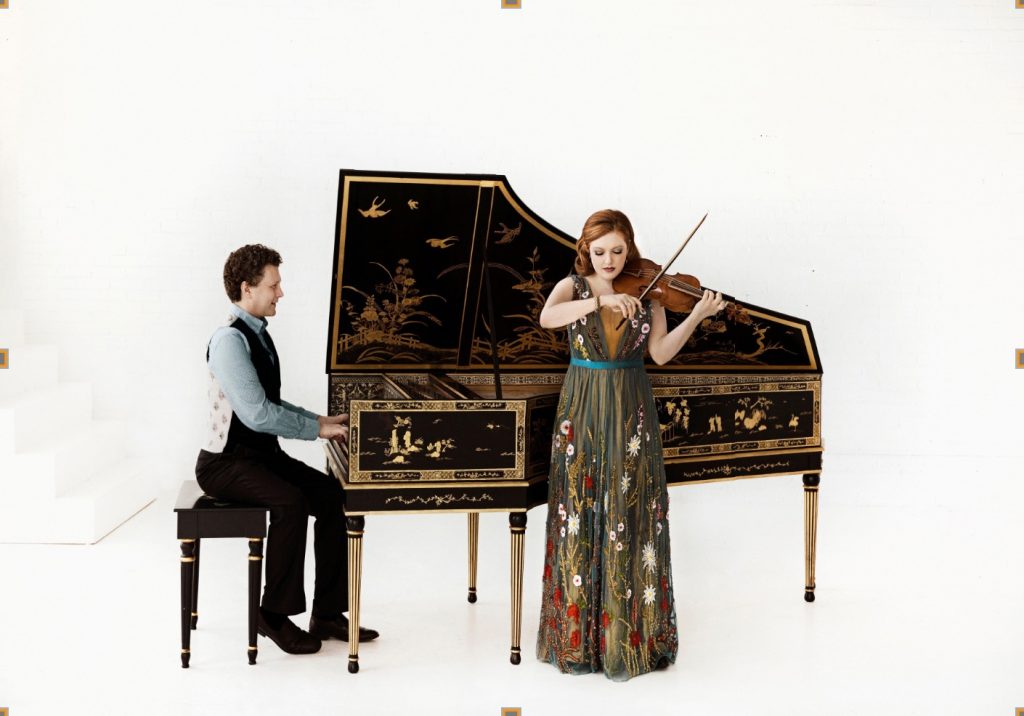Bach As You May Have Never Heard Him
EMN concert features violinist Rachel Barton Pine and harpsichordist Jory Vinikour, offering fresh takes in all-Bach program.
Early Music Now visits the best of J S Bach‘s chamber music as they feature violin virtuoso Rachel Barton Pine and renowned harpsichordist Jory Vinikour on a Saturday, March 4th concert.
Early Music Now concerts stimulate the imagination as they time-travel to another era, exploring music and themes unique to a place and time. Guest artists specialize in specific parts of music history, time-appropriate instruments, and musical ideas. They also use their imagination. Recreating music may be a challenge. The last Early Music concert, on February 4th, required serious scholarship, educated guesses, and creative production to present music from the 4th to 6th centuries. Very little trace of the music of that time exists. Even the unique instruments no longer exist.
This challenge is lessened when fully developed scores and more complete written records exist. JS Bach is one of the most celebrated composers and may be well-known to us today. But Bach lived at a point where musical notation was still incomplete. Although we have all heard Bach’s music, the performances are filtered through the performer’s imagination, who offers an interpretation of the works.
Some performers are renowned not only for their exceptional playing abilities but also for their distinctive interpretations of the music. Rachel Barton Pine has impressed audiences with her virtuosity and bold choices in interpreting musical scores. This is especially challenging with Bach’s scores, which lack clear metric marks, dynamic markings, or special notations for specialized violin techniques. Even complete scores today do not provide guidance on how to play “between the notes,” when to modify tempo from note by note, or what emotions to express. A performer may choose to emphasize a dance rhythm or a musical progression. When a composition weaves two voices together on a single instrument, such as in Bach’s famous chaconne in his Partita No. 2 in D minor, BWV 1004, the challenge becomes separating or blending the two voices. For violinist Nathan Milstein, attention to detail was of utmost importance, while Isaac Perlman aimed to elicit an emotional response by emphasizing the beauty in the music. Barton Pine’s interpretation appears to be in the middle. Should a performer’s unique interpretation be recognizable, or should Bach’s greatness be the sole focus?
The Early Music Now program features Barton Pine on solo violin playing Bach’s Partita No. 2, considered the pinnacle for violinists. The Ciaccona section presents a challenging task for the performer as two distinct voices need to be played simultaneously on the same instrument. See this YouTube for a 46-minute lecture by Barton Pine focusing just on performance options for this section.
The Bach partitas require a great deal of skill to execute accurately. Washington Post critic Joan Reinthaler reflected on a performance of all three partitas by Barton Pine:
She aimed the spotlight not at her own dazzling technique but rather at the music in as astonishing and joyful a performance of all three sonatas and three partitas as I’ve ever heard. There was none of the rhythmic distortion, the little extra time that so many violinists steal to bridge the bow across all four strings and is excused as a stylistic nicety; no posturing at the climax of a series of impossibly fast ornamental turns and no exaggerated phrasing or tempos in the graceful slower dance movements — just elegant ideas realized elegantly.
Vinikour has performed and recorded around the world. With Milwaukee roots, he founded the Great Lakes Baroque, an organization committed to bringing Baroque music to metropolitan Milwaukee. He has often performed and recorded with Barton Pine.
Vinikour will play a solo harpsichord work, the French Overture – Partita in B minor, BWV 831. The work is special in that it features a series of French dance movements that showcase the harpsichord’s unique sound and style. This work consists of two distinct parts – the French Overture and the Partita – with the French Overture featuring a slow, majestic opening followed by a fast fugal section. The Partita then comprises a series of dance movements in a complex and harmonically rich composition.
Barton Pine and Vinikour will collaborate on two sonatas for violin and harpsichord; Sonata for violin and harpsichord in B minor, BWV 1014, and Sonata for violin and harpsichord in G major, BWV 1019. They have recorded all six of the violin and harpsichord sonatas. For most Baroque works, the harpsichord serves a basso continuo background role when matched with other players. For these sonatas, the harpsichord is a full partner.
Each of the four choices in this program is a substantial work. More importantly, we will rarely hear these great works played so well.
The concert will begin at 5:00 p.m. at St. Paul’s Episcopal Church (914 E. Knapp St.) in downtown Milwaukee. Tickets are available for tiered seating online. The seating position can significantly impact the acoustic experience in this church’s long, narrow nave. The central “crossing,” where the performers are located, offers a magnificent acoustic for those sitting near the stage.
The ensemble House of Time performs the next Early Music Now concert, Angels & Demons, on April 29, also at St. Paul’s Episcopal Church. The premise: “Angelic inspiration and demonic possession take turns driving some of the most dramatic works of the Baroque to mythic extremes.”
Preview
-
A Sacred Choir, 70 Voices Strong
 Dec 14th, 2025 by Martha Brown
Dec 14th, 2025 by Martha Brown
-
Prometheus Trio Goes Bohemian
 Dec 3rd, 2025 by Martha Brown
Dec 3rd, 2025 by Martha Brown
-
Present Music Offers New Choral Works
 Nov 20th, 2025 by Michael Barndt
Nov 20th, 2025 by Michael Barndt



















